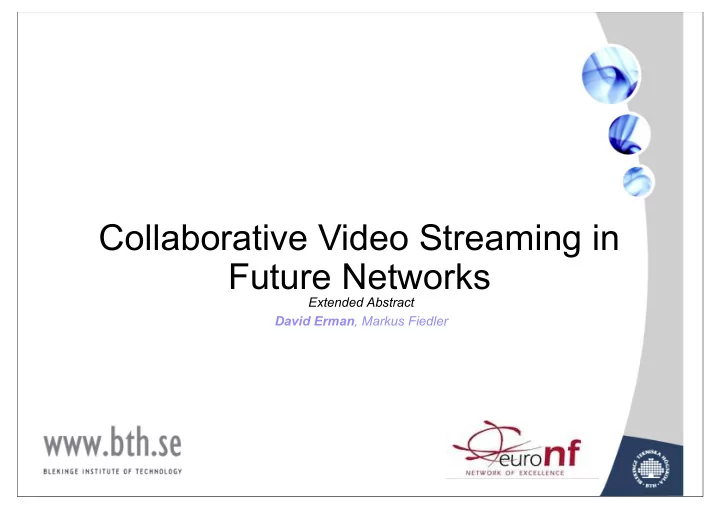

Collaborative Video Streaming in Future Networks Extended Abstract David Erman , Markus Fiedler
The problem(s) • Traditional, multicast-based, video streaming solutions based on traditional view of TV broadcasting • Single producer, many consumers • Good for popular content, and mass distribution of same content • However… • Web 2.0 is here, and users generate much content • Production and consumption patterns change dramatically • Most (99%) videos are not “popular”, i.e., very few people consume each video • No benefit in multicasting non-popular videos
Furthermore… • A typical multicast system uses distribution trees • Ill-suited to handle churn • Future networks likely to be more ad-hoc in nature • Churn will be the norm, not the exception • Summing up: • Current tree-based solutions not likely to be sufficient for VoD
Mesh-based P2P systems • Major contributor to current Internet bandwidth use • Large user base • Quintessential example: • BitTorrent content distribution system • Efficient content distribution using swarming • Originally for distributing large files, but several extensions for streaming video exist
BitTorrent Features • Segmentation • Streams partitioned into discrete segments with associated checksums • Peers exchange buffer maps, indicating what segments they carry • Rudimentary incentive mechanism • Tit-for-tat exchange of segments • Distrust scheme, as opposed to trust scheme • Reciprocation decreases distrust • Peers act as partial caches • Deployment!
One Problem Solved OpenOffice, libtorrent ! 0.12 • Segment download order is random 1000 • Problem solved by smart segment selection • Simulation studies show BT-enabled video 800 streaming uses only about 2% of bandwidth Piece number 600 compared to equivalent Web streaming 400 • So, using BT as a distributor, we can at least provide a streaming service! 200 0 0 2000 4000 6000 8000 Request number
Challenge • Changing production & consumption patterns • cf. youtube,vimeo, et al. • How to map the centralised cloud structure of these networks into the p2p nature of BitTorrent? • Is it even useful? • Adobe Stratus • Take popularity into account?
Challenge • Device & access heterogeneity • Different capabilities of devices, how to distribute load w.r.t. • Storage (caching, pre-fetching) • Processing (transcoding, etc) • Relaying • Access capabilities • How to gracefully adapt content to available bandwidth • Mobility?
Challenge • Peer selection and reputation • Which peers? • Data availability and willingness to share is no longer enough; • Which access? • Account for physical proximity, network proximity, “social proximity”? • Encounter network concepts useful?
Challenge: Video is ugly • Statistical characteristics for video are typically not very nice for the network • Smoothing and pre-fetching can help out, but is difficult to perform in low-bandwidth environments • Given enough bandwidth, it is however possible to outperform IPMC w.r.t. bandwidth utilization
Challenge • Extending the incentive mechanism • Current analysis assume two-player game using bandwidth as cost variable. • More variables must be taken into account, e.g., timely delivery. • Must capture group dynamics, making two-player assumption invalid
Summing up • Mesh file sharing networks have some nice properties useful for video, but there are still open issues: • Segment selection • Peer selection • Incentive mechanisms
Thank you for your time! <?>
Recommend
More recommend